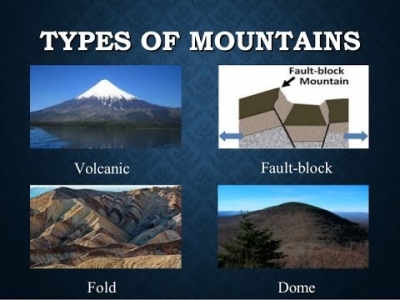
Mountains are formed when the Earth’s tectonic plates move and collide with one another. As the plates continue to move, magma and land may be pushed up, forming mountains.
One other way mountains form is as the result of volcanic activity below Earth’s surface. Sometimes molten rock called magma gets pushed up toward the surface. When that happens, it cools and forms hard rock. Eventually, the softer rock above it erodes to reveal a dome-shaped mountain below. If the magma actually breaks through to the surface, you get a volcano!
Mountains can also form by way of erosion. In an area with a high plateau, rivers and streams can carve away stone in the form of deep channels. Over millions of years, what is left is a mountain between deep river valleys!
Fault-block mountains: Cracks in the Earth’s crust can create massive blocks of rock that then move apart. As they move, one block may slide under another, pushing it up. This leaves large blocks of rock sticking up, high above the Earth’s surface. These are fault-block mountains.
Examples of fault-block mountains include:
- the Sierra Nevada mountains in North America
- the Harz Mountains in Germany
Dome mountains: When large amounts of the magma under the Earth’s crust bubble up towards the surface, layers of rock above the magma are pushed up to form dome mountains. The inside of these mountains is filled with magma that has cooled and hardened. As the dome is higher than its surroundings, erosion by wind and rain occurs from the top. This
results in a circular mountain range. Domes that have been worn away in places form many separate peaks called Dome Mountains.
Fold mountains: These are the most common type of mountain. They form when two or more tectonic plates are pushed together, causing layers of rock on the seafloor to crumple and fold. Over millions of years, these folded layers are slowly pushed up higher to form mountains.
Examples of Fold Mountains include:
- Himalayan Mountains in Asia
- the Alps in Europe
- the Andes in South America
- the Rockies in North America
- the Urals in Russia
Volcanic mountains: A volcanic eruption occurs when magma bubbles up and eventually erupts through a crack in the Earth’s crust. This causes molten rock, known as lava, to flow over the land, before it cools and hardens. Further eruptions create more layers of hardened lava, which build up to form a mountain.
Examples of volcanic mountains include:
- Mount St. Helens in North America
- Mount Pinatubo in the Philippines
- Mount Kea and Mount Loa in Hawaii
Picture Credit : Google




